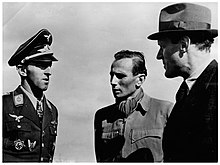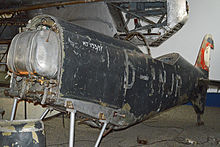Fritz Wendel (Pilot)

Friedrich „Fritz“ Wendel (* 21. Februar 1915 in Monzernheim; † 9. Februar 1975 in Augsburg) war ein deutscher Flugkapitän, Testpilot und Weltrekordinhaber.
Leben
Wendel interessierte sich nach seiner Schulzeit für das Fliegen und bekam eine Position als Fluglehrer bei der Luftwaffe. 1936 wechselte er als Testpilot zu den Flugzeugwerken Messerschmitt und avancierte dort zum Chefpiloten.

Mit einer Messerschmitt Me 209 mit Daimler-Benz-DB-601-Motor stellte er am 26. April 1939 über eine Messstrecke zwischen Augsburg und Buchloe einen Geschwindigkeitsweltrekord für Flugzeuge mit Kolbentriebwerk von 755,14 km/h auf,[1] der bis zum Jahr 1969 nicht gebrochen werden konnte. Am 18. Juli 1942 startete Wendel vom Fliegerhorst Leipheim bei Ulm als erster mit einem serienmäßig gebauten strahlgetriebenen Flugzeug, der Messerschmitt Me 262, zum erfolgreichen Testflug.
Nach dem Zweiten Weltkrieg heiratete er in eine mittelständische Augsburger Brauerei ein. Am 30. Oktober 1950 gründete Fritz Wendel mit Helmut Kaden und Ernst Frank den Augsburger Verein für Luftsport (AVL). Fritz Wendel war, wie auch der Ballonpionier Ernst Frank, Vorsitzender des zugehörigen Augsburger Vereins für Segelflug (AVS). Zeitweise war Wendel auch Präsident des Augsburger Eislauf-Vereins. Im Jahr 1975 beging er Suizid.
Ehrungen
- Goldene Sportplakette der Stadt Augsburg im Jahr 1939.
- In Augsburg wurde die Fritz-Wendel-Straße nach ihm benannt, die gleichnamige Straße in Wachenheim an der Weinstraße ist nach dem Wachenheimer Bürger und Stadtrat Fritz Wendel (1893–1967) benannt, Autor der „Geschichte der Stadt Wachenheim“.
Rekorde und Daten
- 26. April 1939: Als Flugkapitän stellte er mit einer Me 209 V1 einen Geschwindigkeitsweltrekord für Kolbenflugzeuge (755,14 km/h)[1] auf, der 30 Jahre lang halten sollte.
- 18. Juli 1942: Erstflug (mit Strahltriebwerken allein) des ersten in Serie gebauten Flugzeugs mit Strahlantrieb (Me 262 A). Es wurden insgesamt fast 1600 Stück gefertigt.
- 5. November 1943: Erstflug des Prototyps Bf 109 H-0 V54 (Wrk. Nr. 15708). Die „H“ sollte ein Höhenaufklärer werden, jedoch wurde das Projekt wegen Flatterns der Tragfläche und des weiten Fortschritts der Ta 152 eingestellt.
Literatur
- Friedrich (Fritz) Wendel. In: Wolfram Baer: Augsburger Stadtlexikon. 2. Auflage. Perlach, Augsburg 1998, ISBN 3-922769-28-4.
- Fritz Wendel in: Internationales Biographisches Archiv 25/1975 vom 9. Juni 1975, im Munzinger-Archiv (Artikelanfang frei abrufbar).
- Robert Deininger: Augsburg – Porträt einer Fliegerstadt. Presse-Druck- und Verlags GmbH, Augsburg 1995.
Einzelnachweise
- ↑ a b FAI-Rekord Nummer 8743. Abgerufen am 18. Oktober 2023.
Weblinks
- Pilots Notes on ME 262 by Flug Kapitan Wendel (PDF-Datei; 46 kB)
| Personendaten | |
|---|---|
| NAME | Wendel, Fritz |
| ALTERNATIVNAMEN | Wendel, Friedrich |
| KURZBESCHREIBUNG | deutscher Flugkapitän, Testpilot und Weltrekordinhaber |
| GEBURTSDATUM | 21. Februar 1915 |
| GEBURTSORT | Monzernheim |
| STERBEDATUM | 9. Februar 1975 |
| STERBEORT | Augsburg |
Auf dieser Seite verwendete Medien
Autor/Urheber: Alan Wilson, Lizenz: CC BY-SA 2.0
As far as significant airframes go, this machine is near the top of the list. It is the record breaking Messerschmitt Me209V-1 (c/n 1185), which held the world air speed record from 1939 till 1941, and for a piston engined aircraft from 1939 till 1969. During the war it became part of Hermann Göring's personal collection. The fuselage is now displayed in a building full of unrestored relics at the Muzeum Lotnictwa Polskiego. Krakow, Poland. 23-8-2013.
It's history is given in the following info taken from the museum website:-
"By the end of the 1930s a hard-fought competition had developed between Italian, British and German aircraft designers to build a speed record breaking aircraft. As a result of inter-German competition between the Heinkel and the Messerschmitt works, in 1937 in Augsburg the initial works on the “Project 1059” speed record aircraft started. The Third Reich Aviation Ministry (the RLM) designated the aircraft the Me 209 V1, demanding also a fighter version of this machine.
The first prototype of the Me 209 V1 was powered with a 12-cylinder Daimler-Benz DB-601 engine. To achieve the highest maximum speed, the aircraft was almost devoid of equipment.
One of the most interested technical solutions was the cooling system. Water after circling and cooling the engine, turned to a special ducts in the wings, where after partly vaporising through a small holes and condensed on the inner surface of the wing, was directed back to cool the engine. This system featured partial loss of the coolant, so a substantial reserve (200 l) of water was required, thus limiting the time of flight to only 30 minutes.
The Me 209V1 prototype was flown on 1 August 1938 by dr engineer Herman Wurster on the Messerschmitt’s factory airfield in Augsburg. Unfortunately, the violent rise of temperature forced the pilot to quick landing. Further tests of the aircraft revealed several other defects. The most serious was unsteady work of the engine, overheating, interfering of the combustion gasses into cockpit, unsatisfactory visibility on the ground from the pilot’s seat, tendency to a dive during take-off and landing and poor acting of the rudder. All these defects were eliminated to no avail on the second Me 209V2 prototype, which crashed during the test flight on 4 April 1939.
Meanwhile, on 30 March 1939 Hans Dieterle on the competitive Heinkel He 100 V8, broke the speed record, achieving 746 km/h. On 26 April 1939, Fritz Wendel, flying the Me 209 V1 powered by the DB 601ARJ engine, short time rated at 2300 HP, achieved 755 km/h. The part of the fuselage of that aircraft is displayed now at the Polish Aviation Museum. For the better propaganda effect, the Reich Propaganda Ministry, in all publications described the aircraft as the Me 109R, to point out that this is the serial fighter modification, and not a new construction.
The serial production of the Me 209 was never undertaken and the Fritz Wendel’s record for the piston driven aircraft, stood up to 1969, to be beaten by Daryl G. Greenamyer flying the Grumman Bearcat F8F-2 "Conquest I"."Major Hermann Graf (links) im Gespräch mit Willy Messerschmitt (rechts) und Geschwindigkeitsweltrekord inhaber Fritz Wendel (Mitte).

